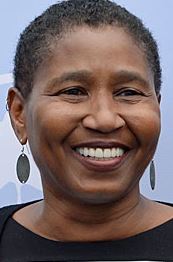 Nobody hates standing around in locker rooms more than basketball reporters. But if the player you are seeking to interview is not there when the media is allowed inside for a 30-minute pre-game access period, you know what you have to do? Wait around.
Nobody hates standing around in locker rooms more than basketball reporters. But if the player you are seeking to interview is not there when the media is allowed inside for a 30-minute pre-game access period, you know what you have to do? Wait around.
Same thing post-game. If a guy is taking a shower, or getting treatment, or lifting weights … you stand around and wait.
It is part of the job, it is somewhat demeaning, and I can see how it would strike an outsider such as Michele Roberts as a situation that needs to be fixed. The Pro Basketball Writers Association has been working with the league’s communications office for years trying to find suitable remedies, often with mixed results.
If a reporter in a small market wants to get a one-on-one interview with a certain player, it is pretty easy to make that happen. A request is put in — either directly to the player or through the team’s media relations department, the interview is set up, and everyone gets to do their jobs. But in major markets with many more media outlets credentialed, the process is neither smooth nor easy. One-on-ones can get hijacked by piggybackers — media members who have no questions of their own to ask, but who need some material. What those people do is eavesdrop without being discreet, hence the nickname piggybackers. They are reviled.
 In New York, where Michele Roberts attends most of the games she sees, the dynamic between the Knicks and the local media has been poor for years. Players often arrive in the locker room one at a time and get encircled by a media mob, and the last player to speak is typically Carmelo Anthony, who often waits an hour or more before speaking. And since he is the most important member of the team, reporters covering the team have no choice but to wait for him.
In New York, where Michele Roberts attends most of the games she sees, the dynamic between the Knicks and the local media has been poor for years. Players often arrive in the locker room one at a time and get encircled by a media mob, and the last player to speak is typically Carmelo Anthony, who often waits an hour or more before speaking. And since he is the most important member of the team, reporters covering the team have no choice but to wait for him.
Believe me, we want to ask a f–king question, as Roberts would put it. But we would like to ask those questions in a timely manner, and when one is forced to wait around for 60-75 minutes before the star player is made available, there is a lot of standing around. Ever idle minute seems to last an hour. It is brutal.
Back in the day, this was not so much of a problem. After every Knicks home game, win or lose, the locker room doors would open and Patrick Ewing would be awaiting the media, his feet soaking in a huge bucket of ice. He would take questions for 7 or 8 minutes, announce “I’m done,” and media people would be free to await secondary players or visit the other locker room to speak to players from the other team.
If Anthony would do what Ewing did, there would be a whole lot less standing around … and there would be better game coverage because that standing around time would be converted to writing time, or on-air time. But apparently, no one has had the foresight to mention this to Anthony since he arrived in New York.
In Dallas, one of the beat writers explained to Dirk Nowitzki the difficulties that ensue when forced to wait an hour or more for him to speak. So what did Dirk do? He started coming out earlier to do his post-game interviews.
I am relating these stories because of the dust-up that was created by Roberts, the head of the players association, in an interview with Kate Fegan of ESPNw, who spent more than her share of standing around time when she was a Sixers beat writer for one of the Philadelphia newspapers.
Roberts said: “Most of the time I go to the locker room, the players are there and there are like eight or nine reporters just standing there, just staring at them,” Roberts said. “And I think to myself, ‘OK, so this is media availability?’ If you don’t have a f—ing question, leave, because it’s an incredible invasion of privacy. It’s a tremendous commitment that we’ve made to the media — are there ways we can tone it down? Of course. It’s very dangerous to suggest any limitation on media’s access to players, but let’s be real about some of this stuff.
“I’ve asked about a couple of these guys, ‘Does he ask you a question?’ ‘Nah, he just stands there.’ And when I go in there to talk to the guys, I see them trying to listen to my conversation, and I don’t think that’s the point of media availability. If nothing else, I would like to have a rule imposed, ‘If you have a question, ask it; if you don’t, leave.’ Sometimes, they’re waiting for the marquee players. I get that, but there is so much standing around.”
 In response to what Roberts said, the Professional Basketball Writers Association released this statement Thursday:
In response to what Roberts said, the Professional Basketball Writers Association released this statement Thursday:
“Members of the Professional Basketball Writers Association stand for fair and responsible journalism. The NBA’s media-access rules do more than protect news outlets; the rules serve the public because the rules facilitate informed, accurate coverage.
“The suggestion that reporters use locker-room access periods to eavesdrop on players’ conversations or to do anything other than work is inaccurate. The NBA’s pregame media-access period provides a vital forum for building constructive relationships between players and reporters. In the vast majority of cases, reporters are in locker rooms before a game because the reporters are waiting to interview players who are in the training room for treatment, on the court warming up or attending pregame chapel services.
“The vast majority of players and the vast majority of our members have positive interactions on a daily basis.
“The PBWA has worked with the NBA in recent years to streamline the daily access periods for players and coaches. Individual players are no longer required to do interviews both at the morning shootaround and during the pregame availability session. The pregame access period has been reduced from 45 minutes to 30. The amount of practice time open to the media has been reduced from 30 minutes to 15. These changes were made to assist players and coaches and reduce their media obligations during their workdays.
“The PBWA would welcome the opportunity to meet with Michele Roberts at any location and time of her choosing to discuss the issues she raised in the espnW.com column.”
Chris Sheridan is publisher and editor-in-chief of SheridanHoops.com. Follow him on Twitter.
I’d like to know the process by which sportswriters are elected to officer positions in the PBWA. Because something seems to be out of whack. For two years, Mary Schmitt Boyer was the successor to Rick Bonnell as President. Anybody with any experience and knowledge of NBA sportswriters knows that
Schmitt Boyer was the laziest and the worst sportswriter to ever grace the position. She was *precisely* the type of sportswriter that Roberts is talking about.
How in the world did she ever get placed into that position? It’s boggled my mind how she ever got herself elected. Is the job that toxic that nobody else in the entire PBWA wanted it? Did everybody else forget to pay their membership dues, so the lone vote was her own, and she won? How are the officers determined?